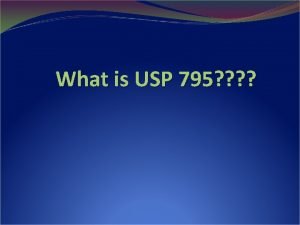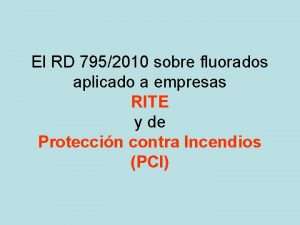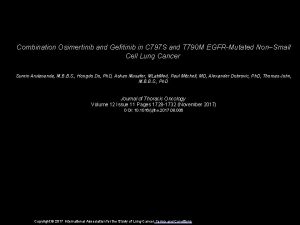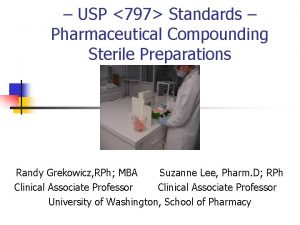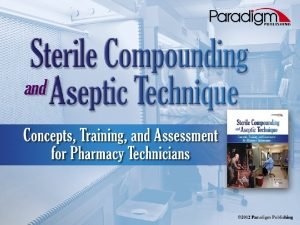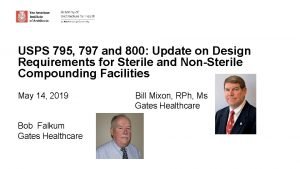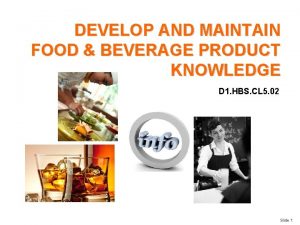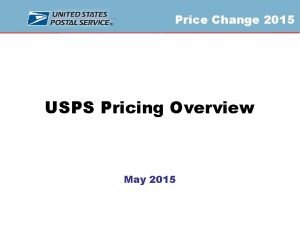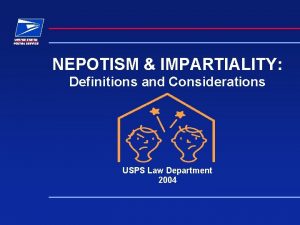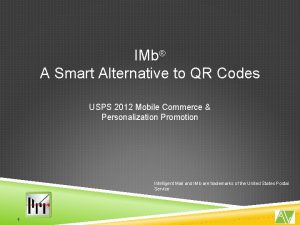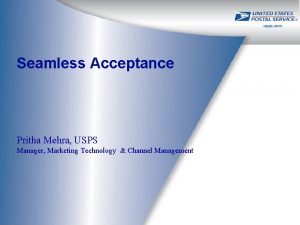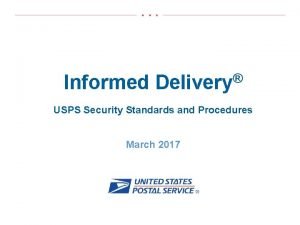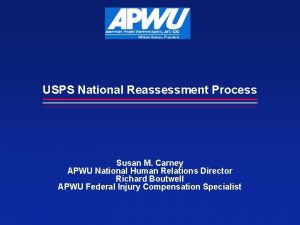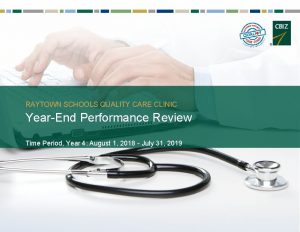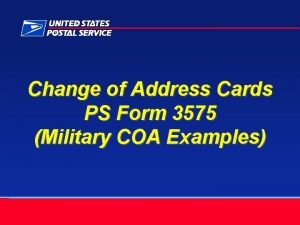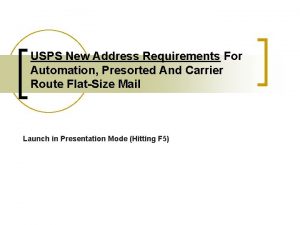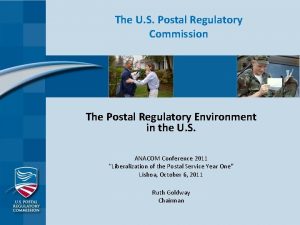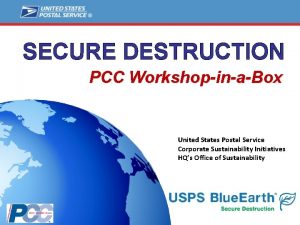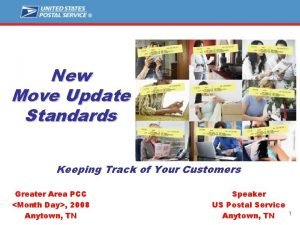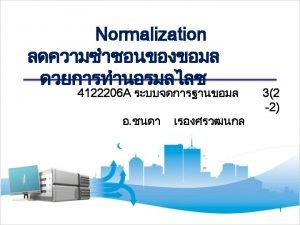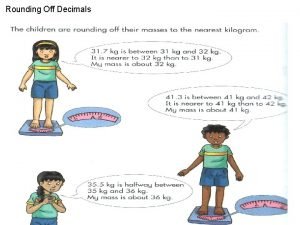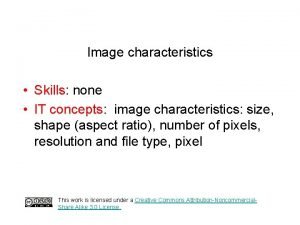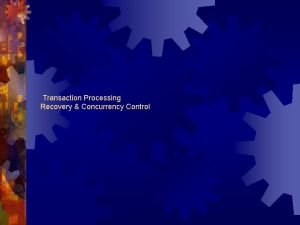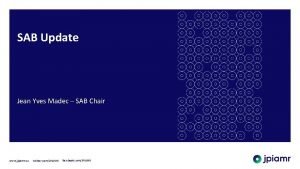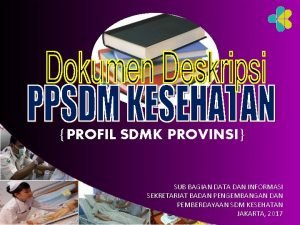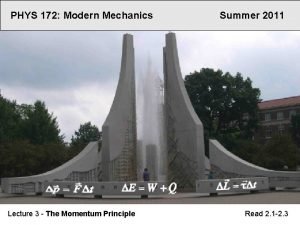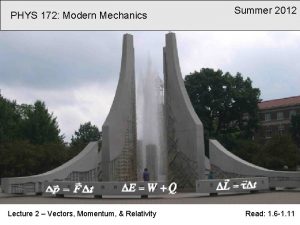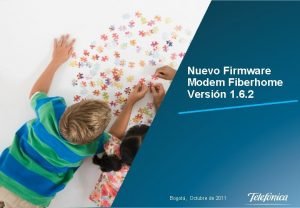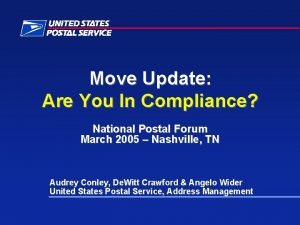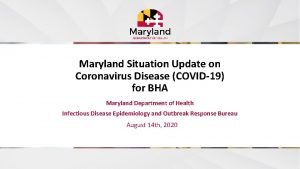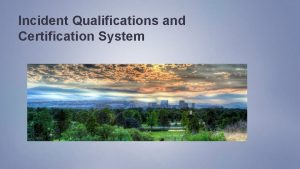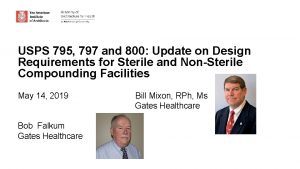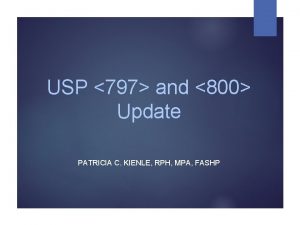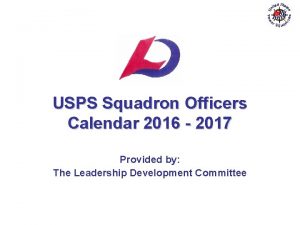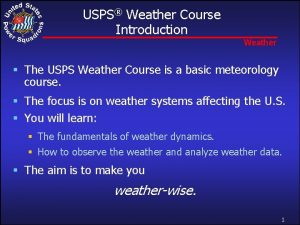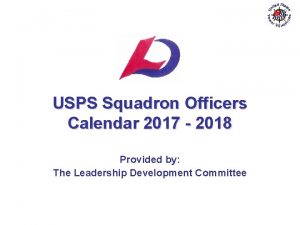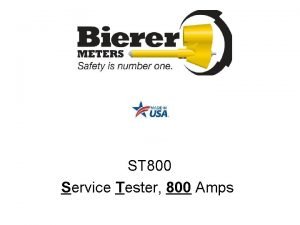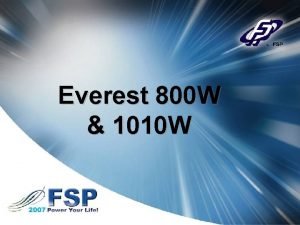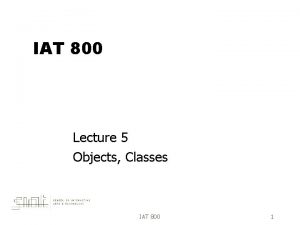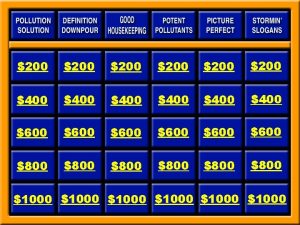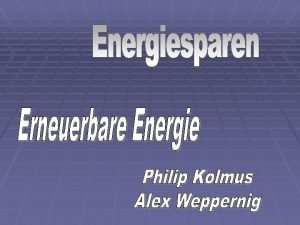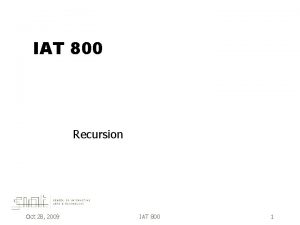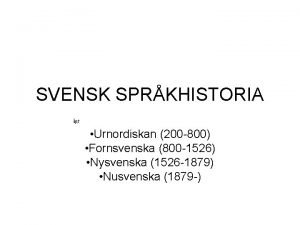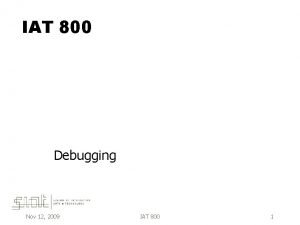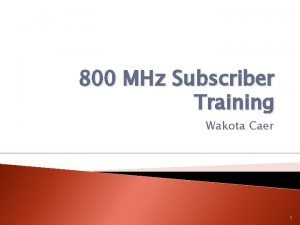USPS 795 797 and 800 Update on Design



















































- Slides: 51

USPS 795, 797 and 800: Update on Design Requirements for Sterile and Non-Sterile Compounding Facilities May 14, 2019 Bill Mixon, RPh, Ms Gates Healthcare Bob Falkum Gates Healthcare

USPS 795, 797 and 800: Update on Design Requirements for Sterile and Non-Sterile Compounding Facilities May 14, 2019 Moderated by: Gregg Ostrow, AIA

HC 101 Series As part of the Academy’s multi-channel, on-line approach, these sessions provide emerging and experienced professionals with convenient and economical opportunities to develop their chosen area of interest. The HC 101 series provides new members of healthcare centric practices with exposure to healthcare design fundamentals

Copyright notice This presentation is protected by US and International Copyright laws. Reproduction, distribution, display and use of the presentation without written permission of the speaker is prohibited. © The American Institute of Architects (year)

Compliance Statement “AIA Knowledge” is a Registered Provider with The American Institute of Architects Continuing Education Systems (AIA/CES). Credit(s) earned on completion of this program will be reported to AIA/CES for AIA members. Certificates of Completion for both AIA members and non-AIA members are available upon special request. This program is registered with AIA/CES for continuing professional education. As such, it does not include content that may be deemed or construed to be an approval or endorsement by the AIA of any material of construction or any method or manner of handling, using, distributing, or dealing in any material or product.

AIA/CES Reporting Details In order to receive 1 AIA LU/HSW credit, each attendee must complete the webinar survey at the conclusion of the presentation. A link will be provided in the chat box and included in a follow-up email one (1) hour after the webinar to the individual who registered your site.

Questions? Submit a question to the moderator via the chat box. Content-related questions will be answered during the Q&A portion, at the end of the presentation, as time allows. Any questions not answered during Q&A, will be answered and posted online within two (2) weeks. Tech support questions will be answered by AIA staff promptly.

Bill Mixon, RPh, MS Gates Healthcare Bob Falkum Gates Healthcare

(USP 797 USP 795 USP 800) Pharmaceutical Compounding Update on USP Standards affecting construction of pharmacy areas - Slide 1 • The United States Pharmacopeia (USP) sets minimum practice standards for pharmacy compounding for the US and 145 other nations worldwide. • The USP Expert Committee for Compounding is comprised of experts in the field. • The Compounding Expert Committee published USP <800> Hazardous Drugs in Healthcare Settings February 2018 with an extended implementation date of December 1, 2019 Gates Healthcare Associates, Inc. www. gateshealthcareassociates. com

(USP 797 USP 795 USP 800) Pharmaceutical Compounding How does this affect me? - Slide 2 • All hospitals have pharmacies that compound sterile and non-sterile preparations • Compounding of sterile preparations occurs in many other clinical settings such as ambulatory surgery centers and physicians’ offices. • The USP through its expert committee sets minimum standards for compounding that must be followed Gates Healthcare Associates, Inc. www. gateshealthcareassociates. com

(USP 797 USP 795 USP 800) Pharmaceutical Compounding Who enforces USP Standards? – Slide 3 Federal law (e. g. The Drug Quality and Security Act of 2013 State Boards of Pharmacy require compliance with USP Standards OSHA and state OSHA agencies have workplace safety requirements HCFA requires compliance with USP Standards as a condition of participation for billing government agencies • JCAHO requires compliance with USP Standards • Attorneys who will represent clients who were harmed after working with hazardous drugs will certainly use non-compliance in their favor. • • Gates Healthcare Associates, Inc. www. gateshealthcareassociates. com

(USP 797 USP 795 USP 800) Pharmaceutical Compounding Preparations –Slide 4 • USP Compounding Expert Committee has finalized all chapters listed above with December 1, 2019 official date. • USP 800 Hazardous products finalized available now. • USP 797 Sterile Compounding finalized available June 1, 2019 • USP 795 Non-Sterile Compounding finalized available June, 2019 Gates Healthcare Associates, Inc. www. gateshealthcareassociates. com

(USP 797 USP 795 USP 800) Pharmaceutical Compounding Hazardous Products used in healthcare - Slide 5 • The National Institute for Occupational Safety and Health (NIOSH) maintains a list of Hazardous Products. • Hazardous Drugs (HDs) must be handled under conditions that promote patient safety, worker safety, environmental protection, and infection prevention. • Access to areas where HDs are handled must be restricted to authorized personnel to protect persons not involved in HD handling. • HD handling areas must be located away from breakrooms and refreshment areas for personnel, patients, or visitors to reduce risk of exposure. • Signs designating the hazard must be prominently displayed before the entrance to the HD handling areas. Gates Healthcare Associates, Inc. www. gateshealthcareassociates. com

(USP 797 USP 795 USP 800) Pharmaceutical Compounding Hazardous Products used in healthcare Slide 6 • HDs must be stored in a manner that prevents spillage or breakage if the container falls. • Do not store HDs on the floor • Avoid storage in areas prone to natural disasters (e. g. , earthquakes) The manner of storage must meet applicable safety precautions, such as secure shelves with raised front lips • Storage room of HDs shall be minimum of 12 ACPH and differential negative pressure of 0. 01” to 0. 03” water column and HD products must be in a spill proof tote or surrounded by a spill lip. Gates Healthcare Associates, Inc. www. gateshealthcareassociates. com

(USP 797 USP 795 USP 800) Pharmaceutical Compounding Hazardous Products used in healthcare Slide 7 • Sterile and nonsterile HDs may be stored together. with at least 12 ACPH. • HDs may be stored within a negative pressure buffer room with at least 12 ACPH, however, only HDs used for sterile compounding may be stored in the negative pressure buffer room. • Refrigerated antineoplastic HDs must be stored in a dedicated refrigerator in a negative pressure area with at least 12 ACPH [e. g. , storage room, buffer room, or containment segregated compounding area (C-SCA)]. • If a refrigerator MUST be placed in a negative pressure sterile buffer room, an exhaust located adjacent to the refrigerator’s compressor and behind the refrigerator should be considered. • Some states will not allow placement in a buffer room and should be avoided if possible, this applies to a double door units also. Gates Healthcare Associates, Inc. www. gateshealthcareassociates. com

Example: Non-Sterile Compounding Facilities <795> & <795>+<800> non Sterile - Slide 8 Gates Healthcare Associates, Inc. www. gateshealthcareassociates. com

Compounding Primary Engineering Control (PEC) <795>Non-Sterile Non-HD Single HEPA PEC - Slide 9 Non-Sterile Non-Hazardous C-PEC Single HEPA Containment Ventilated Enclosure (s) (CVE) no thimble assembly shall be located in a secondary engineering control room (C-SEC). Gates Healthcare Associates, Inc. www. gateshealthcareassociates. com

Example: Non-Sterile Compounding Facilities <797> & <797>+<800> Sterile - Slide 10 Gates Healthcare Associates, Inc. www. gateshealthcareassociates. com

Example: Sterile Compounding Facilities Complete <795> <797> (<795>+<800>) (<797>+<800> - Slide 11 Gates Healthcare Associates, Inc. www. gateshealthcareassociates. com

Sterile Compounding Primary Engineering Control <797> +<800> HVAC 1 - Slide 12 • clean rooms shall utilize a closed loop ducted system, a sealed plenum system, or other similar contamination control system for HVAC systems supplying HEPA-filtered air to ISO Classified spaces. • Supply air provided to classified area(s) shall be provided exclusively through ceiling HEPA filters. • Each secondary engineering control shall have ducted air returns mounted low on the wall in order to create a general top-down dilution of room air with HEPA-filtered make-up air. Gates Healthcare Associates, Inc. www. gateshealthcareassociates. com

Sterile Compounding Primary Engineering Control <797> +<800> HVAC 2 - Slide 13 • Air flow shall be subject smoke studies during dynamic operating conditions that represent the most challenging compounding conditions encountered by compounding personnel in order to demonstrate that compounding personnel performing manipulations and/or equipment used in the direct compounding area inside of the ISO Class 5 environment are not disrupting the flow of first air (HEPA filtered air stream) over critical sites. • HVAC system shall be provided with a MERV 8 followed by a MERV 16 prefiltration system accessible away from the sterile labs. Gates Healthcare Associates, Inc. www. gateshealthcareassociates. com

Non-Sterile Compounding Primary Engineering Control <797> +<800> HVAC 3 - Slide 14 • The HVAC system shall be limited to compounding labs and storage of compounding drugs. • Maintain a not to exceed temperature of 77 F and a suggested relative humidity of 65% monitored daily. • The closed loop designed shall not cross contaminate HD air and engineered to include sufficient air volume and velocity to pre-cool incoming air to proper humidity levels then reheat to satisfy the loads within the room. Gates Healthcare Associates, Inc. www. gateshealthcareassociates. com

ISO Ratings Compounding Facilities Complete <795> <797> (<795>+<800>) (<797>+<800> - Slide 15 • <797> Anteroom NO access to HD <800> Buffer – ISO-8 • <797> <800>Anteroom with access to HD<800> Buffer – ISO-7 • <797> Buffer room – ISO-7 • <797> <800> Buffer room – ISO-7 include a line of demarcation to remove HD clothing before leaving room • <795> Buffer room – no IS 0 requirements • <795> <800> Buffer room – no IS 0 requirements Gates Healthcare Associates, Inc. www. gateshealthcareassociates. com

Air Change Per Hour (ACPH) ISO Ratings Compounding Facilities <795> <797> (<795>+<800>) (<797>+<800> - Slide 16 • <797> Anteroom NO access to HD <800> Buffer - 20 ACPH • <797> <800>Anteroom with access to HD<800> Buffer - 30 ACPH • <797>Buffer room - 30 ACPH with up to half from laminar flow hood(s) (in most states) • <797> <800> Buffer room – minimum 30 ACPH, Likely to be higher volume because of the discharge of all hoods, tumble assemblies, and added exhaust returns vented out doors via house exhaust per local codes and standards. • <795> Buffer room – no IS 0 requirements except normal people conditioning • <795> <800> Buffer room with redundant HEPA filtered hoods – minimum 12 ACPH vented out doors from the room per local codes and standards • <795> <800> Buffer room – single HEPA hoods – minimum 12 ACPH, Likely to be higher volume because of the discharge of all hoods, tumble assemblies, vented out doors via house exhaust per local codes and standards. Gates Healthcare Associates, Inc. www. gateshealthcareassociates. com

Pressure (inches of water gage) Sterile Compounding Facilities <795> <797> (<795>+<800>) (<797>+<800> - Slide 17 • <797> Anteroom door enters NON-HD <797> Buffer room from non ISO area - Minimum 0. 02” W. G. Positive to non ISO area • <797> + <800> Anteroom door enters <707> + <800> HD Buffer room from non ISO area - Minimum 0. 02” W. G. Positive to non ISO area • <797> Non-HD buffer connects to <797> Anteroom- Minimum 0. 02” W. G. Positive to Anteroom • <797> + <800> HD Buffer room 0. 01” TO 0. 03” W. G. Negative to Anteroom • <795> + <800> HD Buffer room 0. 01” TO 0. 03” W. G. Negative to ambient • New (797) standards will require continuous 24/7 monitoring of pressures Sterile only Gates Healthcare Associates, Inc. www. gateshealthcareassociates. com

Temperature and Humidity recommendations Sterile Compounding Facilities <795> <797> (<795>+<800>) (<797>+<800> - Slide 18 • <797> + <800> Rooms shall maintain a temperature of 68 degrees or less • <797> + <800> Recommended maintain a relative humidity of 65% or less with a probe sensor to measure temperature and humidity. • It is suggested humidity shall exceed 30% RH • <797> + <800> Mandated - secondary engineering control shall have a probe or sensor to measure temperature and humidity. Document the temperature and humidity and pressure of each secondary engineering control 24 hours per day, seven days per week, by a continuous recording device. • <795> + <800> Non-Sterile Maintain a not to exceed temperature of 77 F and a suggested relative humidity of 65% monitored daily Gates Healthcare Associates, Inc. www. gateshealthcareassociates. com

Sterile Compounding Facilities <795> <797> (<795>+<800>) (<797>+<800> - Slide 19 • All equipment in an ante room, and buffer room shall be nonporous, non-shedding, impermeable, cleanable, and resistant to degradation by cleaning agents. • All counter tops, work surfaces, and racks, shall be constructed of stainless steel or other non-porous, nonshedding material. • <797> Sterile only - Utilize carts in ISO Classified areas that are constructed of stainless steel, molded plastic, or other non-shedding, non-porous material; and cleanable and resistant to degradation by cleaning agents. Gates Healthcare Associates, Inc. www. gateshealthcareassociates. com

Sterile Compounding Facilities <795> <797> (<795>+<800>) (<797>+<800> - Slide 20 Anteroom or adjacent ISO 8 room prior to Anteroom shall have a stainless-steel sink that: • hands-free controls for water and soap dispensing • Has proper depth and capacity for hand washing up to the elbows; • designed or installed to prevent standing water • Located on the clean side of the line of demarcation away from the buffer room door • Minimizes splashing and dripping of water on adjacent walls and floor. • An anteroom sink may not have an aerator mechanism on the nozzle. • The sink shall be located 1 meter from the USP 797 USP 800 buffer room SEC. Gates Healthcare Associates, Inc. www. gateshealthcareassociates. com

Sterile Compounding Facilities <795> <797> (<795>+<800>) (<797>+<800> - Slide 21 • Utilize light fixtures designed for clean rooms in all areas and the exterior surface of ceiling lighting fixtures shall be smooth, mounted flush with the ceiling surface, and sealed. • Ceiling surfaces in shall be impervious and hydrophobic, ceiling panels, fixtures, and other penetrations through the ceiling or walls shall be smooth and sealed around the perimeter. • Sprinkler heads in all ISO Classified areas shall be recessed, covered, and easily cleanable. • The doors shall be constructed of a nonporous, smooth, nonshedding, impermeable material such as acrylic, polycarbonate or similar fiberglass-reinforced plastic, glass, high grade aluminum or stainless steel; free from cracks and crevices; and cleanable and resistant to degradation by cleaning agents. Doors shall include closures. Doors shall be provided with vision panels. Gates Healthcare Associates, Inc. www. gateshealthcareassociates. com

Sterile Compounding Facilities <795> <797> (<795>+<800>) (<797>+<800> - Slide 22 • Walls shall be made of solid surface, locking sealed panels, or epoxy-coated gypsum board and shall be impervious, cleanable, and non-shedding. • Floors shall be cleanable and composed of wide sheet vinyl that is heat sealed at seams, or other solid, smooth surface. • <797> Sterile only - Floors shall be coved at the wall or appropriately sealed. Gates Healthcare Associates, Inc. www. gateshealthcareassociates. com

Sterile Compounding Facilities <795> <797> (<795>+<800>) (<797>+<800> - Slide 23 • Recommend Anterooms and buffer rooms to be at least 100 square feet. • <797> Sterile only - A buffer room may not contain a sink, drain, or any other source of water. • Buffer room doors should be hands-free ( some states mandate it) • <797> Sterile only - Anteroom and buffer room shall be supplied with HEPA filtered air. • A buffer room shall be physically separated from the ante room by walls, doors, and pass-throughs. Gates Healthcare Associates, Inc. www. gateshealthcareassociates. com

Sterile Compounding Facilities <797>Non-Hazardous or <797> + <800> Hazardous - Slide 24 • <797> Sterile only - An anteroom shall have a line of demarcation that separates the less clean area from the more clean area. • Equipment for non-sterile compounding shall be commercial or pharmaceutical grade • A sink shall be included in or near lab to be available for hand washing as well as emergency access. • The sink shall have hot and cold water, soap or detergent, and low lint single-use towels • An eyewash station and/or other emergency or safety precautions that meet applicable laws and regulations must be provided removal of hazardous substances from eyes and skin Gates Healthcare Associates, Inc. www. gateshealthcareassociates. com

Question Reminder Submit your questions and comments via the chat box.

Pass Thru’s Sterile Compounding Facilities <795> <797> (<795>+<800>) (<797>+<800> - Slide 25 • Be constructed of a nonporous, smooth, non-shedding, impermeable material such as acrylic, polycarbonate or similar fiberglass-reinforced plastic, glass, or stainless steel • Have an interlocking door design • Not be a refrigerator unit. Gates Healthcare Associates, Inc. www. gateshealthcareassociates. com

Sterile Compounding Primary Engineering Control (PEC) <797>Non-Hazardous or <797> + <800> Hazardous - Slide 26 • A containment primary engineering control (C-PEC) is a ventilated device designed to minimize worker and environmental HD exposure when directly handling HDs. • Containment secondary engineering controls (C-SEC) is the room in which the C-PEC is placed. • Supplemental engineering controls [e. g. , closed-system drugtransfer device are adjunct controls to offer additional levels of protection • Sterile and nonsterile HDs must be compounded within a CPEC located in a C-SEC. • Engineering controls are required to protect the preparation and worker from cross-contamination and microbial contamination during all phases of the compounding process Gates Healthcare Associates, Inc. www. gateshealthcareassociates. com

Sterile Compounding Primary Engineering Control (PEC) <797>Non-Hazardous or <797> + <800> Hazardous - Slide 26 • A containment primary engineering control (C-PEC) is a ventilated device designed to minimize worker and environmental HD exposure when directly handling HDs. • Containment secondary engineering controls (C-SEC) is the room in which the C-PEC is placed. • Supplemental engineering controls [e. g. , closed-system drugtransfer device are adjunct controls to offer additional levels of protection • Sterile and nonsterile HDs must be compounded within a CPEC located in a C-SEC. • Engineering controls are required to protect the preparation and worker from cross-contamination and microbial contamination during all phases of the compounding process Gates Healthcare Associates, Inc. www. gateshealthcareassociates. com

Sterile Compounding Primary Engineering Control (PEC) <797>Non-Hazardous or <797> + <800> Hazardous - Slide 27 • The C-PEC must operate continuously if used for sterile compounding or if the C-PEC supplies the negative pressure. • If there is any loss of power to the unit, or if repair or moving occurs, all activities occurring in the C-PEC must be suspended immediately Gates Healthcare Associates, Inc. www. gateshealthcareassociates. com

Sterile Compounding Primary Engineering Control (PEC) <797>Non-Hazardous or <797> + <800> Hazardous - Slide 28 • For entities that compound both nonsterile and sterile HDs, the respective C-PECs must be placed in segregated rooms, unless those C-PECs used for nonsterile compounding are sufficiently effective that the room can continuously maintain ISO 7 classification throughout the nonsterile compounding activity. (Difficult and not recommended) they must be placed at least 1 meter apart and particle-generating activity must not be performed when sterile compounding is in process. • A laminar airflow workbench (LAFW) or compounding aseptic isolator (CAI) must not be used for the compounding of an antineoplastic HD • A BSC or CACI used for the preparation of HDs must not be used for the preparation of a non-HD unless the non- HD preparation is placed into a protective outer wrapper during removal from the C- PEC and is labeled to require PPE handling precautions. Gates Healthcare Associates, Inc. www. gateshealthcareassociates. com

Sterile Compounding Primary Engineering Control (PEC) <797>Non-Hazardous or <797> + <800> Hazardous - Slide 29 • • • Recommended overall floor to deck height = 12’ or greater Pictured is estimated to be 8’ inside the room sitting only recommend a minimum of 8. 5’ Placement of hoods should not be under a HEPA filter Gates Healthcare Associates, Inc. www. gateshealthcareassociates. com

Sterile Compounding Primary Engineering Control (PEC) <797>Non-Hazardous Suggested PEC - Slide 30 • Laminar airflow workbench ("LAFW") Horizontal or Vertical flow Gates Healthcare Associates, Inc. www. gateshealthcareassociates. com

Sterile Compounding Primary Engineering Control (PEC) <797>Non-Hazardous Suggested PEC - Slide 31 Compounding Aseptic Containment Isolator (CACI) Gates Healthcare Associates, Inc. www. gateshealthcareassociates. com

Sterile Compounding Primary Engineering Control (PEC) <797>Non-Hazardous Suggested PEC - Slide 32 • Laminar airflow workbench ("LAFW") Horizontal or Vertical flow • A laminar airflow workbench (LAFW) or compounding aseptic isolator (CAI) must not be used for the compounding of an antineoplastic HD • The C-PEC must be located in a C-SEC, which may either be an ISO Class 7 buffer room (preferred) or an unclassified containment segregated compounding area (C- SCA). • If the C-PEC is placed in a C-SCA, the beyond-use date (BUD) must be limited as defined in 797) Gates Healthcare Associates, Inc. www. gateshealthcareassociates. com

Sterile Compounding Primary Engineering Control (PEC) <797> +<800> Hazardous Suggested PEC - Slide 33 • Class II type B 2 BSCs • Most Frequent for most known HDs, type A 2 cabinets offer a simple and reliable integration with the ventilation and pressurization requirements of the C-SEC. • Class. II BSC or CACI Externally Vented to house air via a thimble assembly blending Buffer room air (approx. 15%) with the BSC exhaust. Gates Healthcare Associates, Inc. www. gateshealthcareassociates. com

Sterile Compounding Primary Engineering Control (PEC) <797> +<800> Hazardous Suggested PEC - Slide 34 • CII B 2 BSC blower discharge assembly(s) shall be engineered to discharge outside the facility consistent within local requirements and codes. The blower system(s) shall be directly connected to the BSC discharging the required air volume as specified by the manufacturer. A second exhaust system shall be required to supplement the BSC discharge. Although not mandated 12 ACPH is suggested. The Blower shall be roof mounted keeping the ducting under negative pressure outside the building. • The roof mounted blower shall be placed subject to local codes for HD exhaust. HEPA filter discharge is not required. Gates Healthcare Associates, Inc. www. gateshealthcareassociates. com

Sterile Compounding Primary Engineering Control (PEC) <795> <800> Non-Hazardous Suggested PEC - Slide 35 Containment Ventilated Enclosure (CVE) single HEPA • Can be recirculated in non-hd room • Requires to be exhausted into a thimble assembly to be collected by house air in HD conditions Containment Ventilated Enclosure (CVE) Redundant HEPA • Can be recirculated in a sterile-hd room as long as the room is exhausting a minimum of 12 acph. Replaces the need for a thimble assembly, easier to place and saves make up air energy. Gates Healthcare Associates, Inc. www. gateshealthcareassociates. com

Sterile Compounding Primary Engineering Control (PEC) <795> Non-Sterile HD Suggested Redundant HEPA PEC - 36 • Non-Sterile hazardous C-PEC redundant HEPA Method: Double HEPA Containment Ventilated Enclosure (s) (CVE) shall be located in a secondary engineering controls (CSEC) hazardous (NIOSH) room and be recirculated within the HD SEC. The SEC room shall maintain a minimum 12 Air Changes per hour exhaust per hour. • The USP 800 USP 795 blower assembly(s) shall be engineered to discharge outside the facility consistent within local requirements and codes. The blower system(s) shall be designed to provide a minimum of 12 ACPH and differential negative pressure of 0. 01” to 0. 03” water column. The Blower shall be roof mounted keeping the ducting under negative pressure outside the building. Gates Healthcare Associates, Inc. www. gateshealthcareassociates. com

Sterile Compounding Primary Engineering Control (PEC) <795>+<800> Non-Sterile HD Single HEPA PEC - Slide 37 • The USP 800 USP 795 blower assembly(s) • Shall be engineered to discharge outside the facility consistent within local requirements and codes. • The blower system(s) shall be designed to provide a minimum of 12 ACPH and include the required exhausted volume of all Containment Ventilated Enclosure(s) (CVE) with thimble assemblies. • The system shall provide a differential negative pressure of 0. 01” to 0. 03” water column. • The Blower shall be roof mounted keeping the ducting under negative pressure outside the building. Gates Healthcare Associates, Inc. www. gateshealthcareassociates. com

Time for Questions and Comments ? ? ? -!!!

CES Reminder The URL to the webinar survey https: //www. surveymonkey. com/r/AAH 1904 will be emailed to the individual who registered your site. The survey closes Friday, May 17, 2019 at 12: 30 am ET. For questions, please email knowledgecommunities@aia. org

Join the Academy of Architecture for Health www. aia. org/aah

Upcoming Webinars Date Series Topic 6/11 HC 101 Series IMEG Webinar (Medical Equipment Planning) 7/9 Beyond the Basics Pre-Post areas of Ambulatory Surgery 8/13 Case Study Series TBD Dates & topics are subject to change
 Database backup and recovery techniques
Database backup and recovery techniques Usp 795
Usp 795 Rd 795/2010
Rd 795/2010 797
797 Avion boeing 797
Avion boeing 797 Low and medium risk sterile compounding quiz
Low and medium risk sterile compounding quiz Hand washing steps
Hand washing steps Who enforces usp 800
Who enforces usp 800 200 + 200 = 400
200 + 200 = 400 Design of gantry girder as per is 800 2007
Design of gantry girder as per is 800 2007 Basic knowledge of food and beverage
Basic knowledge of food and beverage Usps
Usps Usps business customer service
Usps business customer service United postmasters and managers of america
United postmasters and managers of america Usps prices 2015
Usps prices 2015 Usps el 312
Usps el 312 Kala telecom
Kala telecom Qr code usps
Qr code usps Dsspass login
Dsspass login Pritha mehra usps
Pritha mehra usps Http informed delivery usps
Http informed delivery usps Enterprise payment systems
Enterprise payment systems National reassessment process
National reassessment process Intl airlift express
Intl airlift express Raytown wellness center
Raytown wellness center Ps 3575
Ps 3575 Usps.cim
Usps.cim Postal regulatory commision
Postal regulatory commision Usps secure destruction
Usps secure destruction Www.usps.com/newcoa
Www.usps.com/newcoa майл
майл Sql queries for insert update and delete
Sql queries for insert update and delete Data redundancy and update anomalies
Data redundancy and update anomalies 764 to the nearest hundred
764 to the nearest hundred 800 pixels wide and 200 pixels tall pictures
800 pixels wide and 200 pixels tall pictures What is input output design
What is input output design Zechariah
Zechariah Zechariah 2:8-9
Zechariah 2:8-9 University community plan
University community plan Temporary update problem in dbms
Temporary update problem in dbms Www. sab update.com
Www. sab update.com Routing area update
Routing area update Dokumen deskripsi sdmk
Dokumen deskripsi sdmk Gtcs prd examples
Gtcs prd examples Position update formula
Position update formula Position update formula
Position update formula Fiberhome hg6243c firmware download
Fiberhome hg6243c firmware download Move update compliance
Move update compliance Mdh situation update
Mdh situation update Iqcs master record
Iqcs master record Cucm native call queuing
Cucm native call queuing 811 ticket number
811 ticket number

